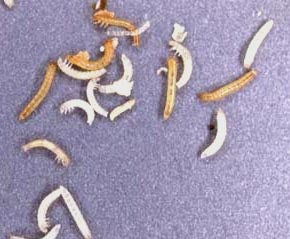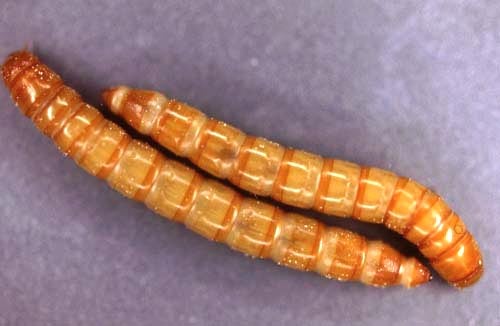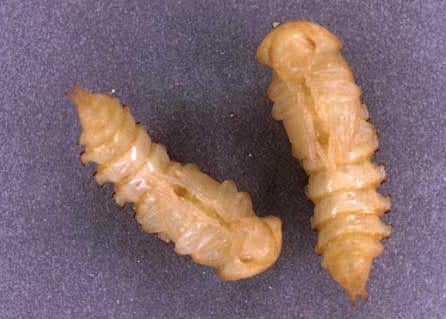Beetle Life Cycle

Mealworm beetles are very different from humans in how they grow up. They pass through 4 different body forms in their complete life cycle. This is called complete metamorphosis. As we have seen, the first form is the egg. A beetle remains as an egg for 7 to 10 days before hatching into the second form, the larva. This is the body form responsible for the "worm" part of the name mealworm. They are very tiny when they first hatch, and it takes them about 3 months before they enter the next body form. During this time, the larvae eat and eat and grow. However, to grow, they must shed their skin every so often. Right after they molt, their skin is white and soft, which allows the animal to grow before their skins hardens and turns tan again in a day or two.
Larvae molt about 15 times and can get very big. Large larvae are what people buy in pet stores or bait shops to feed their reptiles or fish.
 |
 |
When a larva has eaten enough food and grows big enough, it pupates into the third body form, the pupa. While in this form, the beetle does not eat or move very much. The pupa just sits and waits while its insides rearrange into the form needed for the fourth and final body stage. The pupal stage lasts for 7 to 10 days, and finally the pupa ecloses and becomes an adult.
The adult form is what we typically think of as a "beetle." In the final body form, beetles look for other mealworm beetles to mate with and produce offspring to start the life cycle over again.
Read more about: How Do Beetles Reproduce?
Bibliographic details:
- Article: Life Cycle
- Author(s): Dr. Biology
- Publisher: Arizona State University School of Life Sciences Ask A Biologist
- Site name: ASU - Ask A Biologist
- Date published:
- Date accessed:
- Link: https://askabiologist.asu.edu/life-cycle
APA Style
Dr. Biology. (). Life Cycle. ASU - Ask A Biologist. Retrieved from https://askabiologist.asu.edu/life-cycle
Chicago Manual of Style
Dr. Biology. "Life Cycle". ASU - Ask A Biologist. . https://askabiologist.asu.edu/life-cycle
Dr. Biology. "Life Cycle". ASU - Ask A Biologist. . ASU - Ask A Biologist, Web. https://askabiologist.asu.edu/life-cycle
MLA 2017 Style
Be Part of
Ask A Biologist
By volunteering, or simply sending us feedback on the site. Scientists, teachers, writers, illustrators, and translators are all important to the program. If you are interested in helping with the website we have a Volunteers page to get the process started.


